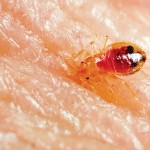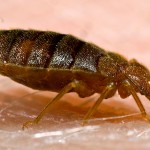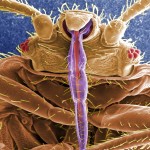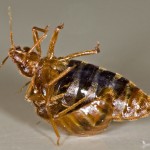Bloodsuckers get out of bed
Bedbugs have reemerged as a global menace — and they may be lurking in the dark near you
By Susan Milius

This story is being written by a person sitting in a bathtub. It doesn’t have water in it, because the person is fully dressed and typing on a laptop computer. This isn’t the most convenient place to work, with a file folder of notes propped on a soap dish and awkward conversations when someone else in the house thumps on the door and asks what’s taking so long.
Bathtubs, however, are very comforting for people writing about tiny, crawling bugs that suck blood. After reading about bugs with needlelike mouthparts that stick into a person’s arm unnoticed (at first, before the itching starts), it’s easy to wonder if that little tickle was a bug tiptoeing on your neck. Or just over and under your sock. A bathtub doesn’t have a lot of places for bugs to hide. A person starting to scratch and twitch can just stand up and look at all the smooth white surfaces to check for anything dark and crawling. That’s why I’ve chosen a bathtub as a place to write about bedbugs, also known as Cimex lectularius.
These insects had become rare in many parts of the world starting in the middle of the last century. That’s when powerful pesticides — or chemicals for killing pests — first came into widespread use. But bedbugs in just a few years developed ways to resist being killed by one of the more widely used early pesticides, DDT. Over more generations, the bugs developed ways to resist other pesticides. And so in the 1990s, bedbugs began to reemerge as a major scourge, and not just in the United States. They also began busting out as a big problem in Europe, Australia and parts of Asia.
Bedbugs don’t kill people or — as far as we know — directly transmit diseases. In 2011, a scientific paper raised questions about whether bedbugs might transmit infections. Tests in Vancouver, Canada, found the bugs carry two kinds of harmful bacteria, nicknamed MRSA and VRE. These germs can cause deep, oozing sores and other infections that very few drugs will treat.

But a lot of people already have those bacteria on their skin. So it’s not clear whether bedbugs increase human infections with MRSA and VRE, points out Jody Gangloff-Kaufmann of Cornell University. She works on Long Island in New York.
Tiny bugs, big problems
Gangloff-Kaufmann specializes in insects common in towns and cities. Because bedbugs were rare when she was a kid, she had no experience with them. So to prepare for working with the returning menace, she found bedbugs and intentionally let them bite her.
Even if bedbugs don’t increase infections, their bites are not fun, she notes. The insects spend the day clustered in small, dark crevices, such as the seams in a mattress or grooves in a bed’s wooden headboard. In the dark, they hike out, covering perhaps the length of a room, to stick those needlelike mouthparts into flesh for a good, warm drink. The bite doesn’t sting like a bee’s. Quite the opposite. A sleeping person usually keeps on sleeping while the bug slurps.
The trouble comes from the bedbug’s spit. While feeding, some of the bug’s spit enters the little hole pierced into a person’s skin. Many people are allergic to several substances in the spit. So bites can swell into red bumps, often in clusters that can look like a spotty rash, and itch insanely.
The problems don’t end there. Bites themselves may become infected, especially if the sufferer scratches the bump open. People can lose sleep and grow miserable and anxious in their own homes. Also, friends and family may avoid visiting the homes of bedbug sufferers for fear of picking up the bugs. And like many allergies, somebody’s response to bedbug bites tends to grow stronger with repeated bites. Gangloff-Kaufmann, for example, says that her first bite took days to swell into a slight bump. People who have been bitten often may start itching within hours.

“Bedbugs are not everywhere, but they can be anywhere,” Gangloff-Kaufmann says. The bugs can squeeze through very tiny cracks, which explains why pest control workers have discovered them in such places as a stereo, TV remote, clock radio — even in the chink in the bricks of a fireplace. In the past few years, reports have emerged of bedbugs having moved into hotels, movie theaters, ambulances, hospitals, college dormitories, airport lounges, clothing stores, government office buildings and lots of other places.
A blood-only diet
Bedbugs feed on more than just humans. On chicken farms, bedbugs attack chickens. Special species of the insects lurk where bats sleep. Other bedbugs thrive in the bird cities that cliff swallows build. Bedbugs don’t need beds. They just need blood.
Not all blood-eating insects need all blood, all the time. Among mosquitoes, for example, blood is for females only. Males don’t touch the stuff, relying on other classic insect foods, such as nectar sipped from flowers. Bedbugs, however, really do live the vampire lifestyle. For them it’s blood and nothing else.
A bedbug hatchling right out of the egg needs at least one hearty, warm, red meal to make it to the next stage of growth. As bedbugs reach adulthood and become about the size and color of an apple seed, they still need blood. A blood meal allows a bedbug to graduate to its next phase of life. For example, before mating, both males and females feed on blood to build up their strength.
But these insects can survive a long time between meals. Just how long depends on the conditions. A study from the 1940s found that bedbugs lived up to 18 months with no blood in a cool (45 degrees Fahrenheit), humid place, but only about six months at 73º F. Experiments with modern bedbugs suggest they may not be as tough.
The need for blood presents a puzzle for scientists who keep bedbugs in the lab to study. Stephen Kells, from the University of Minnesota in St. Paul, says that it took about a year for his lab to figure out how to get the insects to eat reliably. During one tough period when progress seemed to have stalled, one of Kells’ collaborators kept hope and the bugs alive by letting them bite him. Fortunately, the researchers worked out a less-painful system: feeding the insects human blood from blood banks.
Harold Harlan, a retired military expert on the pests, kept his bugs alive by letting them bite him regularly for decades. He explains that he couldn’t find other volunteers, and his wife would have been too upset if he’d used their dog.
Battling the bloodsuckers
Researchers are starting to look at the tough problem of how to control bedbugs — both inside labs and homes. Pyrethroids, the main group of pesticides considered okay to use against bedbugs in people’s houses, no longer reliably kill these pests. Researchers at Ohio State University and elsewhere are now studying bedbugs’ DNA, a long molecule that carries genetic information and is found in nearly every cell of every living organism. The scientists are looking for genetic changes that have allowed the bugs to become immune to these poisons.
With pesticides looking like an iffy solution, other researchers are trying to understand the world as bedbugs smell and taste it. This work, the scientists hope, might someday pinpoint chemicals that could improve bug traps or suggest other tricks for fighting back.

Bedbugs find people in part by sniffing them — and the carbon dioxide that people breathe out appears to strongly attract the bugs. The insects also respond to human skin scents detected from more than twice a human arm’s length away. Whiffs of skin oils or earwax seem to be bug versions of “Mmm, what’s for dinner?” scents. The smell of human perspiration doesn’t appeal, though. Nor, oddly enough, does the smell of plain human blood, either fresh or dried.
Bedbugs make their own chemicals, including some that draw the bugs together in their daytime hideaways. Researchers have also found a compound that males release if another male grabs them and tries to mate. It’s sort of a “Whoa, there, I’m a guy too” signal. It comes in handy, as male bedbugs do seem to grab anything that’s the right size and moving.
Being grabbed by a male bedbug in a hopeful frame of mind looks like something not to take lightly. Males don’t look for a natural opening in the female’s body to insert sperm, their reproductive cells. Instead, males just use a sharp structure to punch a new hole through the female’s body wall. Luckily for bedbugs, the sperm do eventually manage to find their way to a female’s eggs.
Banishing bedbugs
For now, ridding one’s home of bedbugs is quite challenging. Treatments can involve heating all belongings, throwing away possessions that can’t be treated, steaming fabric surfaces and even heating whole rooms. So the best way to protect your own bed (or alarm clock or TV remote) is to learn what the bugs look like and check mattresses, sofas and fabric-covered chairs in homes, hotels and dormitories where you stay. Sometimes the easiest signs of these invaders are blood smears on sheets or the tiny black stains left by their poop.
And bedbug specialists cringe at the idea of even thinking about adopting furniture or electronics left out on curbs for free. Gangloff-Kaufmann has taught her young son to shout “bedbugs” whenever they drive by any such temptation. True, it’s creepy to think about bedbugs so much, but watching for them is the best defense.
And if that starts to creep you out, consider a nice sit in a dry tub to calm your nerves.
POWER WORDS
Pesticide: A poison for killing some kind of pest, such as bedbugs or disease-carrying mosquitoes.
Pesticide resistance: The power to live through being sprayed or treated with pesticides.
Pheromone: A chemical made by an animal. Pheromones drift through the air and send messages to other animals, saying such things as “danger” or “I’m looking for a mate.”
Carbon dioxide: A colorless, odorless gas produced by burning carbon and organic compounds and by breathing. It is naturally present in air and is absorbed by plants in photosynthesis.
Scourge: Something that causes pain or unhappiness.
DNA, or deoxyribonucleic acid: A long molecule in nearly all living organisms that carries genetic information. Each molecule of DNA consists of two strands coiled around each other to form a double helix, a structure like a twisted ladder.







